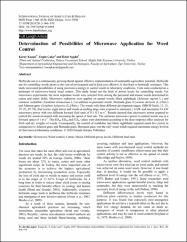| dc.contributor.author | Kaçan, Koray | |
| dc.contributor.author | Çakır, Engin | |
| dc.contributor.author | Aygün, İkbal | |
| dc.date.accessioned | 2020-11-20T14:51:09Z | |
| dc.date.available | 2020-11-20T14:51:09Z | |
| dc.date.issued | 2018 | |
| dc.identifier.issn | 1560-8530 | |
| dc.identifier.issn | 1814-9596 | |
| dc.identifier.uri | https://hdl.handle.net/20.500.12809/1693 | |
| dc.description | WOS: 000432042400003 | en_US |
| dc.description.abstract | Herbicide use is a continuously growing threat against effective implementation of sustainable agriculture potential. Herbicide use for controlling weeds incurs at the cost of environment and is least cost effective. It also leads to herbicide resistance. This study uncovered possibilities of using microwave energy to control weeds in laboratory conditions. Tests were conducted on a prototype of microwave-based weed control. This study found out the limit of power levels for controlling weeds. For microwave experiments, the most important weeds were selected from among the perennial and annual weeds determined in cotton and maize fields. Microwave radiations were applied on annual weeds; black nightshade (Solanum nigrum L.) and common cocklebur (Xanthium strumarium L.) in addition to perennial weeds; Bermuda grass (Cynodon dactylon (L.) Pers.) and Johnson grass (Sorghum halepense (L.) Pers.). The weeds with three different development stages: (BBCH Scale; 12-13, 19-23, 29-33), four leaves, eight leaves and weeds at seeding stage were exposed to minimum 1.6 kW and maximum 5.6 kW microwave power with two different forward feed rates of 0.1-0.3 m s(-1). Results showed that microwave power required to control the weeds increased with increasing the speed of feed rate. The optimum microwave power to control weeds was at a forward speed of 1 m s-1. The ED50, ED80 and ED90 values were determined according to the dose-response effect analyses for fresh and dry weights of weeds. Consequently, the control of cocklebur and black nightshade required much less power in comparison to Johnson grass and Bermuda grass. Bermuda grass was the only weed which required maximum energy level at all feed rates at laboratory conditions. (C) 2018 Friends Science Publishers | en_US |
| dc.description.sponsorship | Ministry of Science, Industry and Technology of TurkeyMinistry of Science, Industry & Technology - Turkey | en_US |
| dc.description.sponsorship | The Ministry of Science, Industry and Technology of Turkey supported this research. | en_US |
| dc.item-language.iso | eng | en_US |
| dc.publisher | Friends Science Publ | en_US |
| dc.item-rights | info:eu-repo/semantics/openAccess | en_US |
| dc.subject | Microwave | en_US |
| dc.subject | Weed Control | en_US |
| dc.subject | Cotton | en_US |
| dc.subject | Maize | en_US |
| dc.subject | Different Power Levels | en_US |
| dc.subject | Different Feed Rates | en_US |
| dc.title | Determination of Possibilities of Microwave Application for Weed Control | en_US |
| dc.item-type | article | en_US |
| dc.contributor.department | MÜ, rtaca Meslek Yüksekokulu, Bitkisel Ve Hayvansal Üretim Bölümü | en_US |
| dc.contributor.institutionauthor | Kaçan, Koray | |
| dc.identifier.doi | 10.17957/IJAB/15.0584 | |
| dc.identifier.volume | 20 | en_US |
| dc.identifier.issue | 5 | en_US |
| dc.identifier.startpage | 966 | en_US |
| dc.identifier.endpage | 974 | en_US |
| dc.relation.journal | International Journal of Agriculture and Biology | en_US |
| dc.relation.publicationcategory | Makale - Uluslararası Hakemli Dergi - Kurum Öğretim Elemanı | en_US |


















